Revell Kit 3197
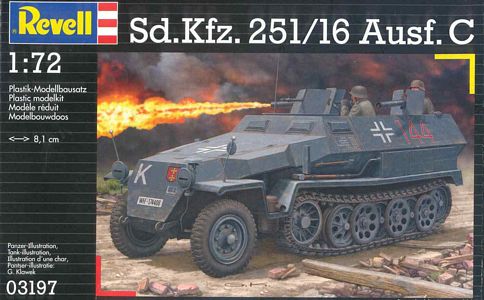
Looking at the very nice box art we see depicted an open top Sd.Kfz. 251 halftrack with the standard MG34 machine gun behind a protective shield at the front over the driver's seat. On either side we see the two flamethrower projectors with shields mounted on the port and starboard sides. Notice the fuel nozzles visible in the wide open flame gun tubes.
Though crewman are depicted on the box art there are no figures within the kit. Based on the storage boxes mounted at the rear of the fenders and the hood sticking out from the side and over the exhaust muffler this is a model C (Ausf. C) version of the Sd.Kfz. 251 halftrack. Behind the protruding hood is a vertical turn signal. In front of the storage boxes are handtools with natural wood handles and a turn signal.
The dark gray vehicle color implies that this vehicle is portrayed prior to summer of 1943. The dramatic artwork gives a convincing idea of the vehicle in action.
Revell's Sd.Kfz. 251/16 Ausfuehrung C kit comes with three sprues for their Sd.Kfz. 251 halftrack kit and an additional sprue-F for the flamethrower parts. Sprue A contains parts for the hull and some roadwheels and sprue B has parts with wheels and link & length tracks. This review will primarily cover the flamethrower aspect of the kit; for a review of the Revell Sd.Kfz. 251 parts please see here and here. Revell's Sd.Kfz. 251/16 kit contains 79 injection molded styrene plastic parts for the hull and chassis, and an additional 42 link & length track parts, plus 19 parts for the flame guns and their fuel tanks. No resin or etched brass parts, or crew figures are included.

Above is a comparison of the Sd.Kfz.251 Ausf. C upper hull from Revell at far right, with ESCI's Sd.Kfz.251 Ausf. C hull to its right. Both are reasonably accurate scale representations. We can make out some slight differences between the Revell welded-construction upper hull and the ESCI (Italeri) upper hull of riveted-construction, particularly with the engine hoods on the sides, pay particular attention to these differences if you wish to convert the ESCI hull to a welded construction.
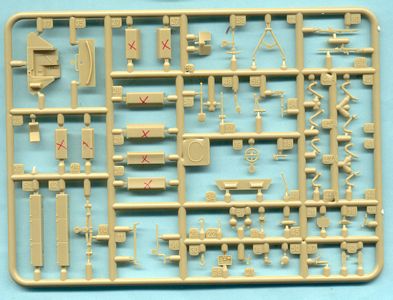
Sprue C above contains the interior parts for the Sd.Kfz. 251 halftrack. Notice the plethora of small delicate parts. Since the internal fuel tanks for the flamethrowers take up much of the internal space the bench seats and storage bins are deleted, these unused parts I have marked with red X's. The V-shaped parts at far right (parts 41 through 44) are for the intricate hinges for the rear passenger door.
At upper right are two very well rendered MG42 machine guns (parts 60) despite that the machine gun portrayed in the box art is an MG34. Be sure not to use the MG42s for an early war vehicle before the MG42 was introduced. A decent MG34 can be acquired from an ESCI Sd.Kfz. 251 halftrack kit. In the center are some great handtools (parts 54, 55, and 57) molded separately rather than molded onto the fenders.
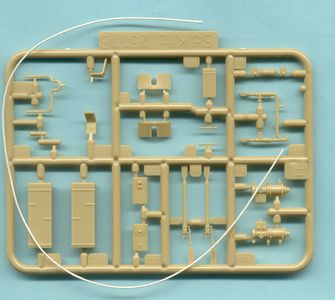
Sprue-F above comes only with this kit of the Revell Sd.Kfz 251 and holds the 20 parts for the flamethrower fuel tanks (parts 107 & 108), the fuel projector engine (parts 99 & 100) the flame guns (parts 95) and the various hoses and piping. The fuel hose is represented by this length of thick white string (part A).
Most parts appear convincingly in-scale and very well detailed, the shields (parts 97) could be improved with etched brass. The muzzle of the flame gun tube could be drilled out.

Revell offers their standard multi-page, black & white, exploded-view assembly instructions with 28 assembly steps. Steps 10 through 13 shown on this page describe assembly of the interior flame thrower parts: the fuel and air pressure tanks, and the piping. From my references this appears to be an accurate representation of the Sd.Kfz 251/16 interior. Perhaps it could be improved with some scratchbuilt and etched brass parts. It does differ from the CMK version in the piping which may be just a variation between and initial Sd.Kfz 251/16 Ausf. C production and the later Sd.Kfz 251/16 Ausf. D production.

Steps 23 through 26 shown here portray the final assembly of the model except the installation of the fuel hoses from the pump engine to the projector barrels (parts 95 in step- 24). Step 23 provides a good view of how different the interior is from the standard personnel carrier version of the Sd.Kfz 251. Compare this to what ESCI gives us in their Sd.Kfz 251/16 kit. A big difference for example is that Revell gives us the correct individual seats for the flame crewmen, while ESCI shows incorrect bench seats with the fuel tanks incorrectly mounted atop them.
Notice that the vehicle width indicators (parts 48 & 49) are included for the front mudguards. The Revell model also includes the turn signals (parts C32), a nice attention to detail. When modeling the rear doors keep in mind that SdKfz 251 In Action states that the rear doors were permanently sealed closed.
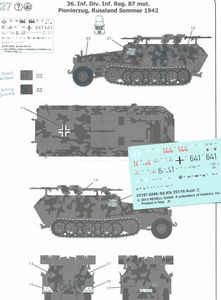
Painting and application of the markings are in Step 27 of the instructions and portray two Sd.Kfz 251/16 vehicles listed as for the 36 Infantry Division in Russia, 1942 and with the 60th Infantry Division in Russia, 1941. I am surprised that this would be listed as with an infantry division as the Sd.Kfz 251 Shuetzenpanzerwagen (SPW) typically served with motorized infantry (panzergrenadier) or Panzer divisions. It is listed as with a Pioneer (assault engineer) unit which is consistent with what I have read. Panzer Tracts No.15.3 confirms that this vehicle served with Pioneer companies within Panzer and Panzergrenadier divisions. Production is listed as starting in January 1943, so it is not possible for the Sd.Kfz 251/16 to have served in 1941 or 1942.
The water slide decal sheet of markings is for this Sd.Kfz 251/16 model kit only and appears in-register and quite colorful. I have not yet used this particular decal set but other Revell decals have applied well for me in the past, if applied over a gloss surface.
CMK/Hasegawa Sd.Kfz 251/16 Flamethrower, Kit 72002 Special Edition

Before beginning I thank modeler and generous friend Doug Chaltry for giving me this kit as a gift. As implied by the title "LIMITED EDITION" this kit was only available for a short time but you may still find one in a shop or model show, and the CMK resin parts may be available as a separate conversion set.
This box art from CMK is particularly helpful in showing multiple photograph views of the completed model kit with photo of the included resin parts and the etched metal fret. Similarities with the Revell kit we have already looked at above are the two flame projectors with swiveling shields. CMK's photos better show the interior fuel tanks, some piping and seating than the Revell box art which will assist in assembly. Note in the Revell artwork are the two vent or drain pipes at the rear, behind the flame guns, going down over the vehicle sides.
I like the photo of the rear showing the open etched-brass doors, the flat rear of the Sd.Kfz 251 Ausf. D, and displaying the pump engine mounted at the rear of the floor. The etched metal engine compartment doors are also open to display CMK's resin Maybach HL42TUKRM engine.
Examining the vehicle closely we can see that CMK has modeled their Sd.Kfz 251/16 on a Sd.Kfz 251 model D (Ausf. D) halftrack, rather than the Sd.Kfz 251 Ausf. C kit that Revell and ESCI use. Notice how the storage boxes are incorporated into the fenders over the track and the upper hull is longer. To my knowledge the Sd.Kfz 251 Ausf. A and B were not used as flamethrower conversions. The plastic 1/72-scale Sd.Kfz 251 model that CMK uses is in fact the fine Hasegawa model. Hasegawa makes several laudable variants of the Sd.Kfz 251 halftracks but not this Sd.Kfz 251/16 variant (see here).
CMK/Hasegawa Sd.Kfz 251/16 Flamethrower, Kit 72002 comes with 21 amber colored cast resin parts, about 50 etched metal parts on one fret, and about 65 light gray color styrene plastic parts on 5 sprue from the Hasegawa Sd.Kfz 251 Ausf. D kit which also comes with two soft plastic band tracks. I state "about 65 styrene parts" as we may or may not wish to substitute some of the etched metal parts. No crew figures are included.
I have seen the CMK resin and etched metal parts come in a separate conversion kit that can instead be used with a Dragon, Hasegawa or ESCI Sd.Kfz 251 kit you already happen to have one in your kit stash.

Here is a comparison of the pale gray colored 1/72-scale Hasegawa Sd.Kfz.251 Ausf. D upper hull at far left with the ESCI (Italeri) Sd.Kfz.251 Ausf. C hull in the center, and a 1/76-scale Fujimi Sd.Kfz.251 Ausf. B hull at right. (At far right in yellow resin is a cast copy of the Hasegawa kit floor that will fit nicely into the ESCI (Italeri) kit lower hull.)

Above is a scan of the 29 resin parts for the flamethrower system and for the vehicle engine. At lower left is a pour plug with the two nicely detailed fuel tanks and to its right are pour plugs with the two flame guns and piping. The center plug looks to be the pump engine for the flame projector while to its left is part of the vehicle engine. At the very top are two pour plugs with the flame projector shields and other parts; I think the flame gun shields would have been better done in etched metal.
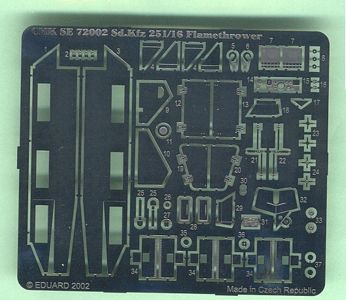
CMK provides a very nice etched metal sheet specially made for this Sd.Kfz 251/16 kit. At far left and bottom are parts 1, 3, 9, 10 and 34 which replaced the kit's plastic storage bins (Hasegawa parts A1 and A2); this is valuable to model the storage bins opened. At right center is the thin metal front machine gun shield which is nice and should have also been produced for the flame gun shields, rather than in resin. The set is nice but I do not see anything that is particular to the Sd.Kfz 251/16 flamethrower vehicle, it looks like a set for the regular Sd.Kfz 251/1 Shuetzenpanzerwagen.

CMK's Sd.Kfz 251/16 assembly instructions replace Hasegawa's Sd.Kfz 251 assembly instructions and incorporate assembly of CMK's resin and etched-metal parts and Hasegawa's plastic parts. The 11-step instructions are clear and appear complete. Step 4 at upper left covers assembly of many of the etched metal parts. Step 6 shows assembly of the flamethrower pump engine.
Compare the parts and these assembly instructions with those of the Revell Sd.Kfz 251/16 Ausf. C kit and note some differences in the flame fuel piping and hoses. The Hasegawa Sd.Kfz 251 Ausf. D kit is the only one of these three that have to option of open front visors (plastic parts D8 or photo etch parts PP28).
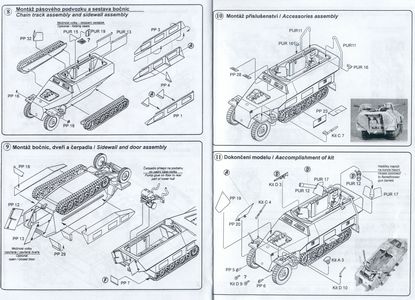
These pages of the instructions show the completed interior and addition of the exterior doors. The small photos of the completed model are helpful. I notice that these instructions depict the rear doors open, though with the flame fuel pump in the way it appears that the crew could not use this doorway to enter or exit.
In these steps we have the assembly of many of the etched brass parts like the rear doors, the side storage lockers, and the engine hatch.
CMK completes their instructions with a black and white camouflage painting guide of an unidentified vehicle and just using several water slide decal Balkenkreuz markings from the Hasegawa decal sheet.
ESCI German Halftrack Sd.Kfz.251/16, Kit 8055
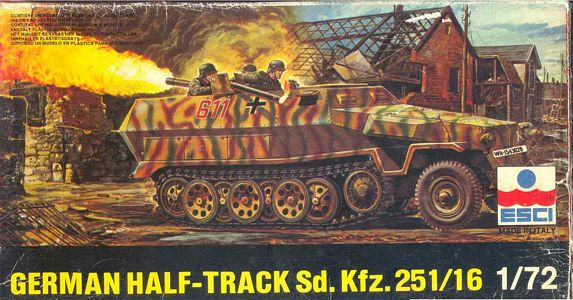
Looking at the kit box art we see a Sd.Kfz 251/16 halftrack with many of the features we have examined on the Revell kit box art. This is a Ausfuehrung C variant of the Sd.Kfz 251 based on the ventilation hoods sticking out from the engine compartment, the pointed rear, the storage boxes affixed to the back of the track fenders, and other features. These kits can be found released by several manufacturers under license with different box paintings, see here for information on this.
In ESCI's boxart here and Italeri's boxart below we can make out the vehicle width indicators on the mudguards over the front tires; the vertical rods with small balls on top. These width indicators are not included in the kit.
A difference here from the Revell Sd.Kfz 251/16 kit is the lack of MG34 machine gun and protective shield at the front above the driver's compartment, and visible rivets holding the armor plates together. What I have read is that the riveted Sd.Kfz 251 halftracks were those assembled in Czechoslovakia before the factory switched to welded construction.
The box art vehicle is painted in a spray-painted 3-color camouflage with a prominent vehicle number. Though the commander's side viewport is portrayed open in the artwork, the side and front viewports are all molded closed in the ESCI (Italeri) kits.
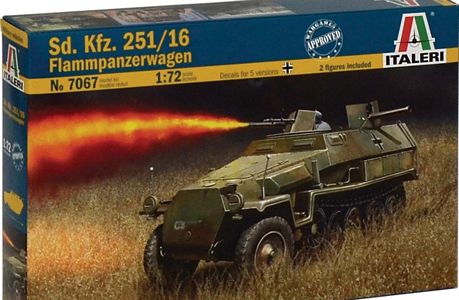
This box photo of Italeri kit No. 7067 I have borrowed from the Italeri website. Italeri has re-released this ESCI Sd.Kfz 251/16 kit with this very attractive box art of the vehicle portrayed in a soft edge 3-color camouflage. Differing from the ESCI box art is that this painting shows the front MG34 and shield. The turn signal visible here behind the engine vent is not actually included in the model kit.
The ESCI Sd.Kfz.251/16 Kit 8055 and Italeri Kit 7067 contain about 50 injection-molded styrene plastic parts for the basic Sd.Kfz 251 vehicle on two sprues, plus 20 additional parts for the FlammFpanzer conversion. In addition there are either 28 styrene plastic link & length track parts or two stiff polyethylene plastic tracks. In my opinion the band tracks are abysmal compared to what we have today (see here for some help in working with this track). ESCI's link & length track has great exterior detail but lacks inside detail such as track guide teeth. Molding quality is good, but I noticed little flash though there can be sink holes on some thick parts. There are two crew figures included, no resin or etched metal parts.
A view of the ESCI Sd.Kfz 251 kit's parts and instructions can be found at Henk's site; Italeri has re-released this old ESCI kit as Sd.Kfz. 251/16 Flammpanzerwagen Kit 7067. A view of the Italeri parts can be viewed at the same site. At this time I have not found any decent reviews of the ESCI or Italeri Sd.Kfz 251 kits.
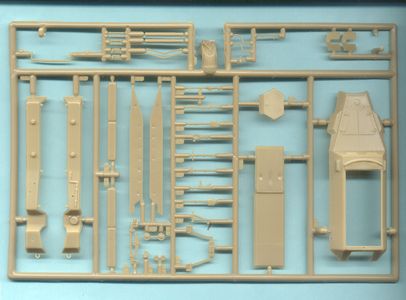
Above is ESCI's and Italeri's sprue holding the Sd.Kfz 251 hull and interior details on the lower part of the sprue. The interiors of ESCI's Sd.Kfz 251 kits are lacking in most of the appropriate detail but in this case for a real Sd.Kfz 251/16, much of the incorrect bench seating and missing storage bins are not installed anyway. In addition to the incorrect fuel tanks, the kit is lacking an accurate flame-fuel pump supposed to be located at the rear on the floor.
The upper part of the sprue holds parts for the Sd.Kfz 251/16 flamethrower version; these parts are not included in ESCI's other Sd.Kfz 251 kits. I do apologize that parts 61, 72 & 73 are missing from my sprue (my fault for not checking the parts before buying the kit at a model show), these parts are the two flamethrower fuel tanks and what is supposed to represent the pump engine. ESCI's part 73 is much to small; all my references show that both flame fuel tanks were the same size.
The ESCI/Italeri kit does come with a pair of very nice MG34 machine guns. This kit is molded in tan styrene plastic though you may also find it in dark gray or pale gray plastic.
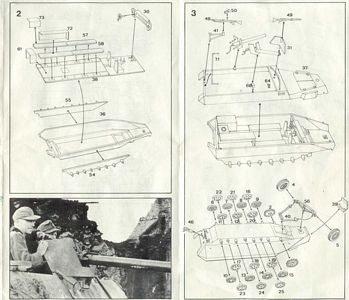
The ESCI Sd.Kfz.251/16, Kit 8055 comes with ESCI's standard exploded-view, black & white assembly instructions which are clear and adequate. I do not own the Italeri re-release of this kit so cannot display the kit instructions for comparison.
In Step-2 at upper left we can see the installation of the flame projector fuel tanks (parts 72 & 72) upon the bench seats which is totally wrong according to my research photos. A simple box represents the flame fuel pump. The flamethrower guns appear reasonably accurate except for no fuel hose to the pump. At lower left is a good historical photo of reference of the flame gun. Just forward of the gun mount is a travel lock for the gun that I did not find in any of these three Sd.Kfz 251/16 models.
On the negative side, all the ESCI Sd.Kfz 251 kits lack the storage bin seat backs and the storage boxes under the bench seats present in the Sd.Kfz 251 Ausf. C and Ausf. D, they lack accurate hinges for the rear door, and the driver's seats are very simplified. On the plus side the overall shape appears accurate and the suspension looks good. A nice thing is that the floor and seats of the Hasegawa Sd.Kfz 251 kit drops right into the ESCI/Italeri kit hull in an almost perfect fit.
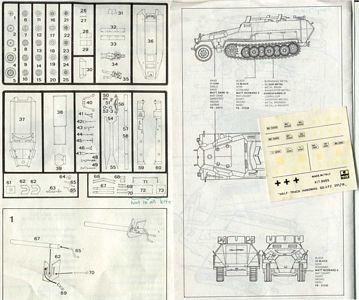
The ESCI assembly instructions include a good parts diagram. Some helpful tips are that parts 66 and 71 are for the vent or discharge pipe going down over the sides from the fuel tanks, and part 63 is a bracket mounted on the rear doors for holding the long hose for a hand held flame gun.
ESCI's water slide decal marking sheet has markings for three Sd.Kfz 251/16 halftracks but I do not see any guide for applying the markings or identification as to the units these markings are for. I also do not see the red 611 marking portrayed in the ESCI box art.
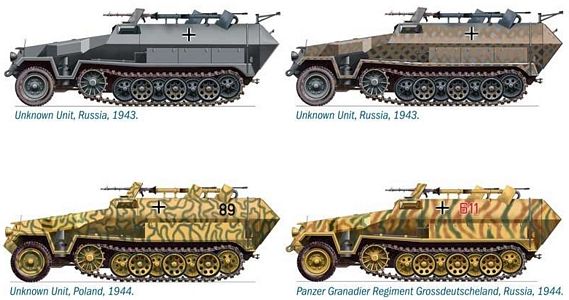
This is a scan from the box art of the Italeri re-release (Italeri kit 7067) of this ESCI kit showing painting and markings for four German Sd.Kfz 251/16 vehicles of 1943 and 1944, including the vehicle portrayed in ESCI's box art.
Conclusions
The Revell Sd.Kfz 251/16 kit appears to be a first-class kit with good external and interior detail. This is one Sd.Kfz 251 variant that Dragon has not released in their 1/72-scale Sd.Kfz 251 series so I find this Revell kit most welcome. I find it very odd that Revell would portray makings for vehicles in 1941 and 1942 when it was supposedly not constructed till 1943. Crew member figures would be great. I am puzzled why Revell did not include MG34 machine guns in addition to the MG42s.
The CMK Special Edition kit also appears to be a very admirable kit with a very good resin conversion set for the Hasegawa Sd.Kfz 251 kit. The resin and brass parts should also be usable with the 1/72-scale Dragon Sd.Kfz 251 Ausf. D kit. The Hasegawa kit holds up well compared to the more recent Dragon model and CMK is known for quality resin and etched metal parts. The CMK resin and etched metal conversion can be purchased separately.
Things to keep in mind when comparing this ESCI kit with the Revell and the CMK Sd.Kfz 251/16 kits, are the ESCI kit's age and the standards expected by small-scale modelers in the 1970s and 1980s. At the time this model was released in the 1980s or so, these kits were the best available and greatly desired. Alas, today they are considered very simple for a display model. This kit could also be found under other kit numbers depending on which manufacturer had the molds.
My assessment of the ESC/Italeri Sd.Kfz 251 kits is that they are best for wargaming but require much work to build it into a good display model. Looking at this another way though, doing some super detailing to the ESCI/Italeri kit may be a fun exercise. Etched brass sets may be found for all three of these halftrack kits. There are some details of these vehicles and the kits I did not venture into, please see your references for particulars.
References
Panzer Tracts No.15.3 mittlerer Shuetzenpanzerwagen (Sd.Kfz.251) Ausf.C & D, Thomas Jentz and Hilary Doyle (2006). ISBN 0-9771643-5-7. My personal favorite reference with period photos and accurate scale drawings. (www.panzertracts.com)
Flammpanzer Tank Power Vol. LVI 285, by Janusz Ledwoch, Wydawnictwo MILITARIA, (2007) Polish and English text. ISBN EAN 9788372192851
FLAMMPANZER German Flamethrowers 1941-1945, New Vanguard 15, by Tom Jentz, Hilary Doyle and Peter Sarson, Osprey Military (1995). ISBN 1 85532 547 0
Achtung Panzer website
SdKfz 251 In Action, by Charles Kliment and Don Greer, Squadron Signal Publications Armor series No. 21. ISBN 0-89747-124-5. A good but old reference book with a single page on the Sd.Kfz 251/16.




















